

Lithium America
Nestled in the heart of Nevada's Humboldt County, the Thacker Pass project by Lithium Americas is poised to become a pivotal player in the global lithium market. This region, known for its vast landscapes and rich mineral deposits, has caught the attention of investors and environmentalists alike.Li
Read More

Discover Your Dream Home in Winnemucca, NV: 5950 Packsaddle
Are you ready to embrace the charm and tranquility of a brand-new home in the heart of Winnemucca, Nevada? Look no further than 5950 Packsaddle, a stunning new build located in the Western Village subdivision. This beautiful property is now available for $499,000 and offers a perfect blend of modern
Read More

Why you should go local !!!!
In the ever-evolving world of real estate, making informed decisions is crucial, especially when it comes to buying or selling a property. One of the smartest moves you can make is to hire a local real estate agent. Here's why going local can be a game-changer for sellers and buyers alike. First and
Read More

Interest rates
As we move through 2023, interest rates continue to be a hot topic in the real estate market. Whether you're a first-time homebuyer or a seasoned investor, understanding the current mortgage landscape is crucial for making informed decisions.Mortgage interest rates have seen fluctuations over the pa
Read More
Categories
Recent Posts










GET MORE INFORMATION
